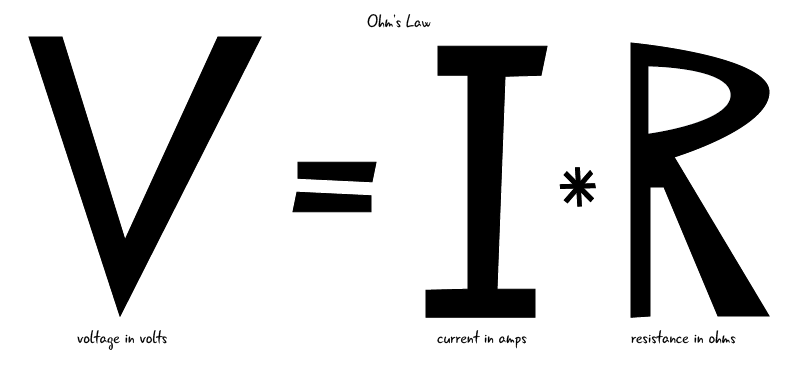Chapter 4: Ohm’s Law
How do voltage, current, and resistance interact: Ohm’s Law
Voltage, Current, and Resistance are related through a formula named Ohm’s Law. Ohm’s law states that in a given circuit, the voltage (in volts) is equal to the current (in amps) times the resistance (in ohms):
This equation shows us that, no matter how much pressure (voltage) there is, if the resistance is high the current will be restricted. This is true for all electrical wiring.
One benefit of Ohm’s law is that if we know any two of the electrical properties, we can always calculate the value of the third property.

Since we have already learned how to measure the values of voltage and current in our circuits, we can calculate the voltage, current, or resistance depending on which property we don’t know.
Ohm’s law in a circuit
Now we know about Ohm’s law, but how will it help us make our circuits? We can use Ohm’s law to determine the value of the resistors we need in our circuits. We can also use Ohm’s law as a safety check to confirm that the values of voltage and current running through are components are below the limits for those components.
For example: if we have a resistor in our circuit which has 220 ohms of resistance, and there is 20 mA (which is the same as 0.020 Amps), running through the circuit, then we can use Ohm’s law to figure out how much voltage will pass through the resistor.

Ohm’s Law applied
How else can we use Ohm’s Law? Let’s say we want to build two circuits that each contain one LED and one resistor. We’re going to power one circuit with 3.3 volt pin on the Arduino, and another with the 5 volt pin (recall that the Arduino can provide either voltage.) The LEDs we’re going to use in the circuits take 2.2 volts to light up fully, and use 25 milliAmps, or 0.025 A. Because of the voltage difference between the two circuits, we will need different resistors in each circuit to protect the LEDs. What resistor value will we need for each circuit?
Since we know that 2.2 volts are going to pass through the LED in each circuit, we can take the difference between our provided voltages (3.3 volts and 5 volts) and 2.2 volts to figure out how much voltage will pass through each resistor.

Now we can use Ohm’s law to calculate how much resistance we need to have the stated voltage and a current of 0.025 amps pass through the resistor protecting our LED.

The 5 volt circuit requires a higher value resistor than the 3.3 volt circuit. We can see that using Ohm’s law shows us how the value of the resistor required changes in our circuit based on the voltage provided. Ohm’s law is useful for making sure our components are provided with the the right amount of electricity.
Arranging components in a circuit
We’ve learned how to use our multimeter to test electrical properties in a circuit and how to test the value of resistors. We’ve also learned about voltage, current and resistance, and how they interact with each other using Ohm’s Law.
Back to the components in our circuit: how do we know how to arrange them? We know that the circuit must form a complete loop. Some components seem to be arranged next to each other which common electrical points, while others are connected end to end. What do we call these arrangements, and what effect does it have on the electrical properties in the circuit?